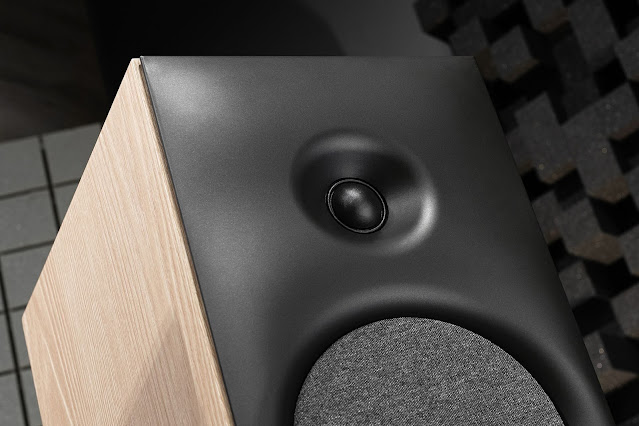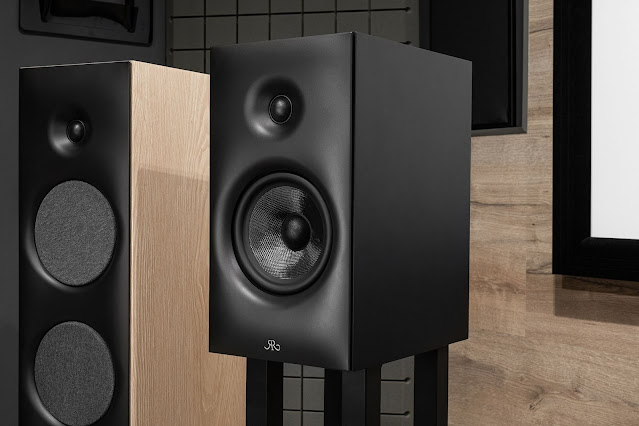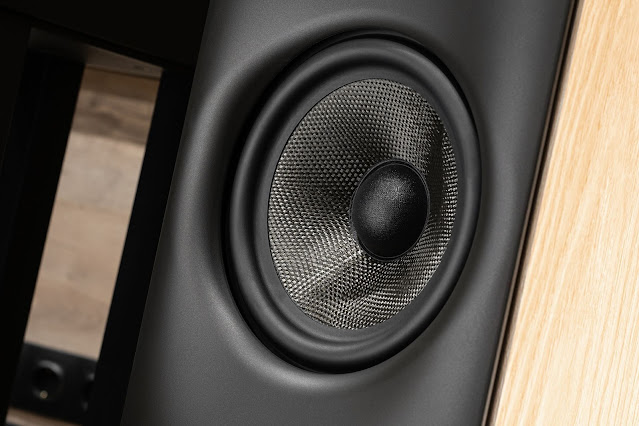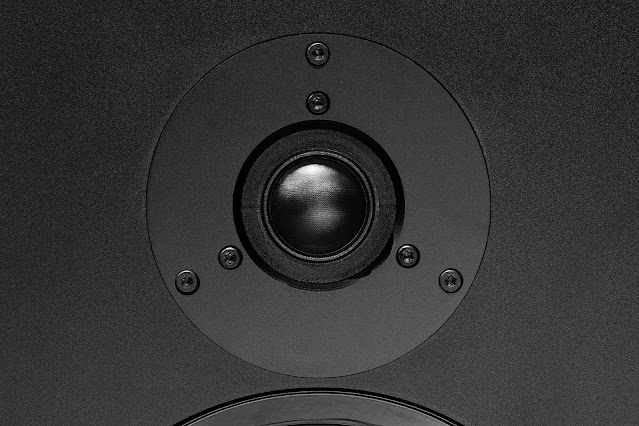Revival Audio Sprint 3 and Sprint 4 review
They say that it is much more difficult to maintain leadership than to achieve it - and just such a task is being solved before our eyes by Jackie Lee and Daniel Emont, the founders of Revival Audio. They entered the market quite boldly, presenting high-tech rack-mounted shelves in retro design with rich finishes. Both models, released under the Atalante name, made a very positive impression on the expert community ( and on me ) and turned out to be very popular on the market.
The second entry and attempt to gain a foothold in the world of high-end audio is a demonstration of more traditional and affordable Sprint speakers, made in a modern design with floor-standing columns and medium-sized bookshelves.
Prices for new items pleasantly pleased: Sprint 3 and Sprint 4 cost about half as much as Atalante 3 and Atalante 5, respectively. The speakers at first glance are the same, which means that the prospects in terms of sound quality are very good. After listening to the older model at the Fresh Hi-Fi & Vinyl Show in Moscow, I received preliminary confirmation of this, but such issues need to be dealt with in more detail.
Versatile design
The appearance of the novelty was developed in the Parisian design studio A + A Cooren, whose specialists have already collected many awards and have previously worked on Atalante acoustics. As in the older model, several styles are woven together in the design of the Sprint at once.
Rectangular cabinets with classic colors reflect the modern take on home speakers, but they are combined with a front panel that has aerodynamic smooth curves - like a professional studio speaker.
The elegance of the overall picture is added by the support of floor stands and branded racks for shelf speakers decorated with brass spiked legs and, of course, the company logo with a beautiful ligature. Very well crafted color scheme. All three finishes of the cases are perfectly combined with the dark chocolate tone coloring, in which the front panel is made.
It must be admitted that the designers did their job perfectly, because the mixture of completely different styles and elements is so harmonious and whole that it does not cause a feeling of eclecticism, and everything together looks absolutely appropriate. And most importantly, with this approach, Sprint will fit into almost any interior, even modern, even classic. And, of course, 100% Sprint recognition is guaranteed. As is the case with the older model.
Proprietary technologies
Both drivers of the Sprint models are based on the same set of technologies and materials as in the older models. The dome of the tweeter has an increased caliber of 28 mm, its fabric is impregnated with the original RACS composition, which gives additional rigidity and ensures piston operation.
The dome is mounted on an asymmetric suspension, which saves it from resonances and bending loads during operation. Under the dome is an ARID+ diffuser that eliminates unwanted reflections without creating a compression effect.
By the way, the manufacturer even calculated the effectiveness of this method: according to the company's estimates, the proprietary diffuser eliminates more than 95% of all resonant phenomena that occur under the tweeter dome! But it doesn't end with the ARID+ diffuser alone. Its design is not monolithic and has through channels through which air from under the dome penetrates through the core of the magnetic system into the rear, again antiresonant BCD chamber, where all unwanted reflections and the overtones they form are completely destroyed.
The main feature of the mid-woofer is the BSC cone, which is a three-layer sandwich using felt as a damping material and with an outer layer of basalt fiber. Let me remind you that Revival Audio pioneered the use of basalt fibers to create speaker cones.
While the declared technologies are identical, the dynamics have some visual differences when compared with those installed in the Atalante series. Probably, there are some differences in the design, but the developers chose not to focus on them. The main focus in the Sprint model is shifting to a new technology - ELYTRON: this is the same front panel that looks like the facade of a studio monitor.
The visual similarity of this panel with professional acoustics is dictated solely by the laws of physics, because in fact ELYTRON is one large waveguide, the task of which is to control the directivity of the emitters and minimize sound reflections from the front panel. This eliminates coloration, reduces distortion and creates a more accurate sound image at the listening point.
Of particular interest is the fact that the ELYTRON panel is removable and mounted on magnets. If you remove it, you can insert a fabric grill into the holes located opposite the midrange / woofer (or speakers, if we are talking about floorstanding speakers). Moreover, the grill is assembled on a round frame without rigid grilles or jumpers - opposite the speaker cone there is only a stretched fabric and nothing more.
The acoustic design of both models of the Sprint series is bass-reflex. The floorstanders have two ports: one at a height of about 30 cm from the floor, and the second - right under the top edge. If you suddenly need to take control of the bass by eliminating the phase inverters from the workflow, this arrangement of ports gives more opportunities for fine-tuning the bass response.
Both the Sprint 3 and Sprint 4 feature phase-linear crossovers with a small number of parts, some of which are made to order, while others have been rigorously selected for quality and parameter stability. The final adjustment of the crossovers was carried out manually, exclusively by ear.
As Daniel Emont said, “Measurement can make a good crossover, but only experience and craftsmanship can help you make something truly extraordinary.” Pathetic, but true and to the point. And, probably, so that the tuning results could not be spoiled by biwiring or biamping, the developers installed only one pair of terminals.
Magic waveguides
I don't know the real reasons why the developers decided to make the front panel removable, but I will assume that the grills are just an excuse. In general, all this is very similar to a provocation, the purpose of which is to make the user appreciate the effectiveness of ELYTRON technology. After all, it is absolutely impossible to resist listening to all possible options: with a panel and grills, with a panel without grills and, of course, bare acoustics without everything.
From the last version, the test listening began. We launch a track with atmospheric, surround sound - and begin manipulations. The first thing worth noting is that the process of removing and installing both the panel itself and the grills is simplified as much as possible through the use of magnets. However, you should not relax. Installation and removal must be done with the utmost care, since the Sprint tweeter is not protected in any way and there is no special grill for it.
Acoustics without a waveguide panel scatters sound as widely as possible and, as a result, more evenly fills the room with sound. The radiation axes can be placed parallel to each other, this has a positive effect on filling the room, and nothing fundamentally changes at the listening point: whether the speakers are directed at it or not, the result is approximately the same - a very wide, but flat stage. In addition, when listening without an ELYTRON panel, the sound lacks integrity, and the acoustics are easily localized by ear.
With grills installed, the effect is reversed - the radiation becomes narrowly focused, the speakers need to be turned to the listening point. The sound is still tied to the acoustics, but the volume and feeling of the recording space are better transmitted (for which, however, the tweeter is responsible, which does not have a grill). In addition, grills somewhat reduce detail and intelligibility in the midrange, although it should be noted that the engineers did their best to avoid this.
Without grills, ELYTRON panels transform the sound of acoustics and create real magic, giving the sound of mid-budget speakers signs of serious High End. Firstly, with installed panels without grills, the sound picture is completely untied from the location of the speakers in space, the scene is drawn with holographic accuracy and unlimited volume.
Secondly, there is a sense of realism and perfect tonal balance in the mid/high range. Thirdly, the detailing increases, as a result of which the timbres of the voice and acoustic instruments are transmitted more fully and accurately. To get the maximum effect, the speakers should be placed in the traditional way - in a triangle, pointing at the listener.
Balance on a fundamental basis
The difference in sound between floorstanders and bookshelf speakers was absolutely obvious and fully in line with expectations. If the little Atalante 3s were bassy enough to be mistaken for floor standing speakers, the Sprint 3s deliver an honest shelf sound with no pretensions to deep bass. At the same time, Sprint 4 floorstanders create such a solid and powerful low-frequency foundation that the thought of a subwoofer does not arise. In other words, everything is like a textbook.
It is curious that in both cases the nature of the sound and the presentation of the musical material are absolutely identical. Both floorstanders and bookshelf speakers produce a spacious, expressive and realistic sound, perfect for relaxing home listening to music for your own pleasure.
High frequencies, with all the transparency and purity, are as accurate as possible and not intrusive. They protect the listener from harsh sounds and annoying sibilants, thanks to which violins and strings in general sound very comfortable and not aggressive. Brass also does not hit the ears, and the whistling and tsiking sounds in the vocals do not irritate.
The middle is drawn as detailed as possible, with rich timbres and a noticeable bias towards warm tones, thanks to which it is perceived as exceptionally lively and expressive. This is especially evident on recordings of vocals, acoustic guitar, as well as when listening to jazz and chamber classics. And electronic music performed by Sprint ceases to be mechanical, acquiring a barely noticeable analog color.
Bass punch combines elasticity and softness, due to which it is not prone to hard aggressive attack. When listening to the familiar test recordings, there was a feeling that these acoustics give out a little more bass than they should be, as if the low-frequency timbres were set to +2.
The effect is observed both on the floorstanders and on the bookshelves, which is why low male voices sound especially rich and rich. This presentation does not irritate at all, on the contrary: the music from this sounds more pleasant and comfortable.
It is important to note that all the shades of sound, which are now understandable branded sound signature of Revival Audio, are strictly dosed. In combination with transparency, a holographic stage, good macro dynamics and excellent rhythm, this allows acoustics to confidently cope with almost all musical genres.
Even metal sounds quite decent: the guitar is legible, the instruments do not fall into a mess, the dynamics and rhythm are at their best, the top is not aggressive and not sharp, but at the same time it is well readable. Add a little more clarity and focus on the lower frequencies - and it would be perfect. All audiophile records, modern popular music and even complex electronics are reproduced successfully and do not cause any complaints.
verdict
Returning to the beginning, I propose to evaluate what Revival Audio offers us in the new Sprint series and how this will help the company gain a foothold in the market. Both models demonstrate a comfortable sound, unobtrusive highs, expressive mids (especially the lower ones), soft and at the same time powerful bass. Excellent rhythm speaks of the high accuracy of the crossover settings. The branded waveguide overlay literally works wonders, convincingly proving that the developers do not eat their bread in vain and know exactly what they are doing.
The same can be said about design. By entrusting it to a third-party company, the creators of Sprint did not fail. In a word, wherever you look, only professionalism is observed everywhere. No childhood illnesses and no by-products of free creative exploration, usually inherent in young brands. All decisions are mature, balanced and balanced, which inspires respect and disposes to oneself.
In the end, the user receives high-quality acoustics, which, on the one hand, has its own pronounced character, and, on the other hand, fits perfectly into any interior and confidently copes with any music. In my opinion, this is a rather rare combination and a serious claim to repeat the success of the flagship models.
Pros
musical and expressive sound, holographic stage, the ability to change the character of the sound and appearance
Cons
no tweeter protection
OFFICIAL SITE
Revival Audio Sprint 3 , Revival Audio Sprint 4
Revival Audio specifications
Sprint 3
HF: 28 mm, fabric dome
MF/LF: 180 mm, basalt fiber sandwich
Frequency range: 55-22000Hz (-3dB)
Crossover Frequency: 1800Hz
Sensitivity: 87 dB
Impedance: 6 ohms (actual - not less than 4.5 ohms)
Amplifier power: minimum 30W, nominal 150W
Dimensions: 380x213x307 mm
Weight: 9.1 kg
Sprint 4
HF: 28 mm, fabric dome
MF/LF: 180 mm, basalt fiber sandwich
LF: 180 mm, basalt fiber sandwich
Frequency range: 45-22000Hz (-3dB)
Crossover frequency: 1.6 and 2.2 kHz
Sensitivity: 89 dB
Impedance: 4 ohms (actual - not less than 3.8 ohms)
Amplifier power: minimum 30-50 W, nominal 180
Weight: 20.6 kg






















.jpg)



0 Comments